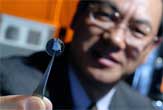
A new class of devices aims to convert energy created from body movement, the stretching of muscles or the flow of water to power future nanoscale components.
These so-called "nanogenerators" would be less bulky than traditional energy sources such as batteries.
Zhong Lin Wang of the Georgia Institute of Technology and graduate student Jinhui Song have created a prototype nanogenerator that produces electrical current through the bending and relaxing of zinc oxide nanowires.
When the nanowires flex, they emit a piezoelectric discharge, which is electricity generated by certain materials under mechanical stress.
A nanometer is one billionth of a meter; a human hair is roughly 100,000 nanometers wide.
Because zinc oxide is non-toxic, the new nanogenerator could be implanted safely into the body.
"Our bodies are good at converting chemical energy from glucose into the mechanical energy of our muscles," Wang said. "These nanogenerators can take that mechanical energy and convert it to electrical energy for powering devices inside the body."
Get the world’s most fascinating discoveries delivered straight to your inbox.
Wang thinks such devices could be used wherever mechanical energy is available. The hydraulic motion of seawater would work, or the motion of a foot inside a shoe.
"You could envision having these nanogenerators in your shoes to produce electricity as you walk," Wang said. "This could be beneficial for soldiers in the field, who now depend on batteries to power their electrical equipment. As long as the soldiers were moving, they could generate electricity."
The device is detailed in the March 14 issue of the journal Science.
